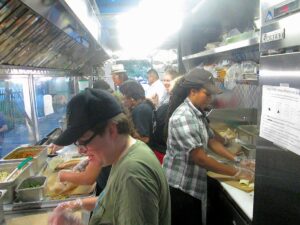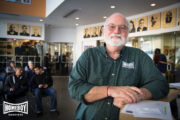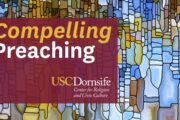From the rise of evangelical hipsters to the rise of religious “nones,” religion is in a period of flux as we end one year and look forward to the next. Here at the USC Center for Religion and Civic Culture, we study how religions change and make change in the world. Below are five trends that we are watching, paired with headlines you might see in The Onion in 2016. In other words, don’t take our “predictions” too seriously. But there’s often great truth in satire.
Trump Alienates “Papists” During Pope’s Trip to Mexico
Donald Trump has already maligned Latinos and Muslims in his presidential campaign, so it only seems natural that Catholics will his next target. As Pope Francis follows the migrant route to the U.S.-Mexico border in February, an attack on Catholics will keep Trump in the headlines just as the first few primary results role in.
Seriously, though, Pope Francis’ message of hope and mercy may pose problems for certain U.S. politicians in 2016. The New York Times recently analyzed 95,000 of Trump’s words and found his rhetoric to be overwhelmingly fearful and violent. Pope Francis’ words from his U.S. trip stand in sharp contrast to Trump’s. Even as many are turning away from religious institutions, the leader of the world’s largest religious institution is articulating a message that resonates broadly. On his trip to Mexico, he will capture many hearts north of the border, too, possibly igniting a new push for compassionate immigration reform.
Nothing is too outrageous for Trump, but alienating the Catholic swing vote wouldn’t serve him well if he makes it past the primaries. By the time we reach the general election, we predict that Americans will want a more hopeful leader. We’ll be betting on whatever candidate best taps into Francis’ spirit of hope – the word, not coincidentally, that took Barack Obama to the White House eight years ago.
(Photo Credits: Pope Francis: mcstkorea / Flickr Trump:
New Hashtag Goes Viral: #SpiritualLivesMatter
From university campuses and town hall forums, to churches, synagogues and mosques, to our political arenas and talk shows, people are talking about race, thanks in a major part to Black Lives Matter, the hashtag turned social movement.
No, we don’t actually think #SpiritualLivesMatter will or even should go viral, but activists have found that they have to care for their spiritual lives to sustain themselves. Yes, many of these socialist-leaning, Marxist-studying social justice activists believe profoundly in the spirit and practice it, not only in their homes, but in their protests.
BLM chapters and affiliates have become a spiritual home to a new generation of activists. They use altars at their protests and burn sage when standing before police lines. They practice traditional African faith rituals, such as Ifa and Santeria, and turn to healing techniques such reiki and somatics as a form of self-care.
BLM also embraces all parts of the black community, including the Queer and Transgender communities. This radical inclusion and the promotion of acceptance have led to tensions between BLM activists and traditional religious leaders.
In 2016, the BLM movement may have an impact well beyond our police departments. BLM may push churches to grapple with their acceptance of LGBTQ people. Look for BLM to also influence and create new communities of spiritual practice within social justice circles and beyond.
While BLM is definitely not church, it is spirit infused, and that spirit has given it power.
32 Percent of Evangelical Pastors Have At Least One Tattoo Visible While Preaching

Well, maybe not exactly 32 percent, but an unmistakable hipster aesthetic will become more prominent behind the pulpit of many evangelical churches. Though Millennials are less likely than any generation of Americans before them to maintain a religious affiliation, evangelical churches are thriving among the waves of Millennials who have poured into cities like Los Angeles over the last decade.
Currently, three of the largest churches in the city of Los Angeles, Hillsong, Oasis and RealityLA, are comprised almost exclusively of 20-somethings. Megachurches are no a longer suburban phenomenon; they now rent out central city theaters and school auditoriums. Justin Bieber even made the Staples Center into a megachurch this fall, according to the LA Times’ review of his concert.
As cities continue to transform and attract recent college graduates, singles and young families—the type of people who would have never considered city-life twenty years ago—evangelical churches will continue to appear in unlikely urban spaces. As they continue to grow, they also will draw more people into cities’ core spaces and speed up gentrification processes that are already running hot.
We’ll be watching how these dynamics unfold—including both the role urban churches play in their communities and how a hip, urban environment affects evangelical churches. The pros and cons to this sort of urban development depend on a person’s perspective, but one thing is for sure: The tattoo parlors will be happy.
Evangelical Pastor Declares, “We’re all Queer!”
LGBT issues have long been a part of mainline Protestant denominations; by now, LGBT people are largely accepted as just other members of the church. Evangelicals have taken a much more oppositional stance to LBGT acceptance. The Supreme Court decision declaring same-sex marriage bans are unconstitutional has presented a problem for many evangelical groups, but for others, it just underscores how they were already thinking about their role in the larger culture.
In 2016, we’ll be watching how evangelical churches and other organizations, such as colleges, universities and seminaries, adjust. We predict that an increasing number will show greater acceptance of LGBT individuals, in essence “de-queering” their identities just as mainline Christians have done. And not all of the LGBT-accepting evangelicals will be the ones with tattoos (see above). In turn, this will produce a non-negotiable line for other evangelical organizations, where we will see a hardening of their position on LGBT issues, creating a rift within the evangelical world over LGBT issues.
Also watch for pushback from parts of the young LGBT community that do not want acceptance from any church organizations. These groups are already partnering with broader justice movements, including Black Lives Matter (see above), to find healing through alternative spiritual practices.
Silicon Beach Venture Capitalists Venture into Religion
The tech industry isn’t the only one innovating these days. Several groups essentially serve as the R&D divisions for long-standing religious institutions in Southern California. Holy Ground in Long Beach and Thad’s in Santa Monica are “off-the-books” laboratories of the Episcopal Diocese of Los Angeles where the beliefs and rituals that have traditionally defined mainline Protestantism are pulled apart and reassembled in remarkable ways. Similar experimental enclaves exist within Jewish and Muslim communities.
 Maybe the most innovative groups in the Los Angeles area are informal, service-oriented gatherings like Laundry Love, Share-A-Meal and Monday Night Mission. These initiatives attract young participants from an array of religious traditions, as well as large contingents of religious “nones,” to provide meals or free laundry to the homeless and working poor.
Maybe the most innovative groups in the Los Angeles area are informal, service-oriented gatherings like Laundry Love, Share-A-Meal and Monday Night Mission. These initiatives attract young participants from an array of religious traditions, as well as large contingents of religious “nones,” to provide meals or free laundry to the homeless and working poor.
These loosely organized groups aren’t likely to coalesce into new religious institutions on their own—that’s definitely not the intention motivating the people who started them. But by creating religiously diverse networks of volunteers around the common impulse to help those in need, they could provide the DNA for new communities that will be unlike the churches, mosques and temples we currently know.
Whether or not they attract the attention of venture capitalists—Facebook’s Mark Zuckerberg did launch his own version of innovative philanthropy this year—we’ll be watching Southern California’s spiritual R&D laboratories closely to see which ones succeed or fail. The religious equivalent of Facebook or the iPhone could emerge from the one of them at any moment.




